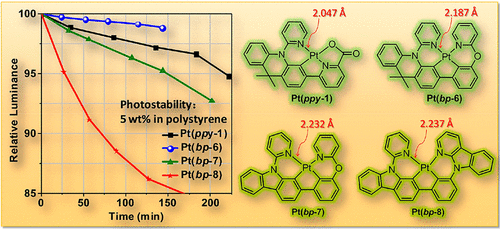当前位置:
X-MOL 学术
›
Inorg. Chem.
›
论文详情
Our official English website, www.x-mol.net, welcomes your
feedback! (Note: you will need to create a separate account there.)
Phosphorescent Tetradentate Platinum(II) Complexes Containing Fused 6/5/5 or 6/5/6 Metallocycles
Inorganic Chemistry ( IF 4.3 ) Pub Date : 2020-11-26 , DOI: 10.1021/acs.inorgchem.0c02569 Guijie Li 1 , Gang Shen 1 , Xiaoli Fang 1 , Yun-Fang Yang 1 , Feng Zhan 1 , Jianbing Zheng 1 , Weiwei Lou 1 , Qisheng Zhang 2 , Yuanbin She 1
Inorganic Chemistry ( IF 4.3 ) Pub Date : 2020-11-26 , DOI: 10.1021/acs.inorgchem.0c02569 Guijie Li 1 , Gang Shen 1 , Xiaoli Fang 1 , Yun-Fang Yang 1 , Feng Zhan 1 , Jianbing Zheng 1 , Weiwei Lou 1 , Qisheng Zhang 2 , Yuanbin She 1
Affiliation

|
A series of phenylpyridine (ppy)-based 6/5/5 N*C^N^O and biphenyl (bp)-based 6/5/6 N*C^C*N Pt(II) complexes employing tetradentate ligands with nitrogen or oxygen atoms as bridging groups have been developed. Ligand structural modifications have great influences on the electrochemical, photophysical, and excited-state properties, as well as photostabilities of the Pt(II) complexes, which were systematically studied by experimental and theoretical investigations. The time-dependent density functional theory calculations and natural transition orbital analyses reveal that Pt(bp-6), Pt(bp-7), and Pt(bp-8) have dominant ligand-centered (3LC) mixed with small metal-to-ligand charge-transfer (3MLCT) characters in T1 states, resulting in relatively low quantum efficiencies (ΦPL) of 5–33% and 12–32% in dichloromethane solution and PMMA film, respectively. By contrast, Pt(ppy-1) possesses much more 3MLCT character in the T1 state, enabling a high ΦPL of 95% in dichloromethane and 90% in DPEPO film, and large radiative decay rates. The strength of the Pt–N1 coordination bond plays a critical role in the photostability. Pt(ppy-1)- and Pt(bp-6)-doped polystyrene films demonstrate long photostability lifetimes of 150 min for LT97 and LT98.5, respectively. A Pt(ppy-1)-based green OLED using 26mCPy as host realized a peak EQE of 18.5%, which still maintained an EQE of 10.4% at 1000 cd/m2, and an Lmax of over 40 000 cd/m2 was achieved. This study should provide a valuable reference for the further development of efficient and stable phosphorescent Pt(II) complexes.
中文翻译:

含熔融6/5/5或6/5/6金属环的磷四齿铂(II)配合物
使用四齿配体和氮的一系列基于苯基吡啶(ppy)的6/5/5 N * C ^ N ^ O和基于联苯基(bp)的6/5/6 N * C ^ C * N Pt(II)配合物作为桥连基团的氧原子已被开发出来。配体的结构修饰对Pt(II)配合物的电化学,光物理和激发态性质以及光稳定性具有很大的影响,已通过实验和理论研究对此进行了系统地研究。随时间变化的密度泛函理论计算和自然跃迁轨道分析表明,Pt(bp -6),Pt(bp -7)和Pt(bp -8)具有以配体为中心的显性(3LC)用小的金属-配体电荷转移(混合3 T中MLCT)字符1个状态,从而导致相对低的量子效率(Φ PL的5-33%,并且在二氯甲烷溶液中和PMMA薄膜12-32%),分别。与此相反,铂(PPY -1)具有更3在T MLCT字符1状态,可实现高Φ PL的二氯甲烷95%,在DPEPO膜90%,以及大的辐射衰减率。Pt–N 1配位键的强度在光稳定性中起关键作用。Pt(ppy -1)-和Pt(bp-6)掺杂的聚苯乙烯薄膜分别对LT 97和LT 98.5表现出150分钟的长光稳定性。的Pt(PPY -1)基使用26mCPy作为宿主实现18.5%的峰值EQE,其仍保持了10.4%的EQE在1000cd /米绿色OLED 2以及大号最大值超过40 000烛光/米2已实现。这项研究应为进一步开发有效和稳定的磷光Pt(II)配合物提供有价值的参考。
更新日期:2020-12-21
中文翻译:

含熔融6/5/5或6/5/6金属环的磷四齿铂(II)配合物
使用四齿配体和氮的一系列基于苯基吡啶(ppy)的6/5/5 N * C ^ N ^ O和基于联苯基(bp)的6/5/6 N * C ^ C * N Pt(II)配合物作为桥连基团的氧原子已被开发出来。配体的结构修饰对Pt(II)配合物的电化学,光物理和激发态性质以及光稳定性具有很大的影响,已通过实验和理论研究对此进行了系统地研究。随时间变化的密度泛函理论计算和自然跃迁轨道分析表明,Pt(bp -6),Pt(bp -7)和Pt(bp -8)具有以配体为中心的显性(3LC)用小的金属-配体电荷转移(混合3 T中MLCT)字符1个状态,从而导致相对低的量子效率(Φ PL的5-33%,并且在二氯甲烷溶液中和PMMA薄膜12-32%),分别。与此相反,铂(PPY -1)具有更3在T MLCT字符1状态,可实现高Φ PL的二氯甲烷95%,在DPEPO膜90%,以及大的辐射衰减率。Pt–N 1配位键的强度在光稳定性中起关键作用。Pt(ppy -1)-和Pt(bp-6)掺杂的聚苯乙烯薄膜分别对LT 97和LT 98.5表现出150分钟的长光稳定性。的Pt(PPY -1)基使用26mCPy作为宿主实现18.5%的峰值EQE,其仍保持了10.4%的EQE在1000cd /米绿色OLED 2以及大号最大值超过40 000烛光/米2已实现。这项研究应为进一步开发有效和稳定的磷光Pt(II)配合物提供有价值的参考。











































 京公网安备 11010802027423号
京公网安备 11010802027423号